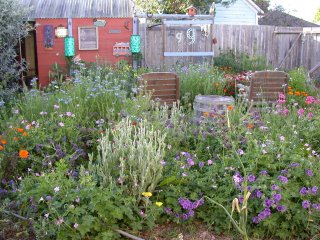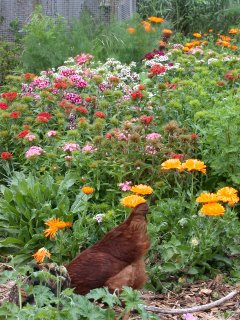Nothing irritates me more than these stories about how gardening as a leisure activity is on its way out. In this week's San Francisco Chronicle,
John Hershey writes:
"Are you aware of the impending demographic crisis facing our country? ...In a recent poll, the number of Americans who list gardening as one of their favorite leisure activities plunged from 15 percent in 1995 to 6 percent. "
This leads to all sorts of hand-wringing over the cause of this terrible decline and what on earth we might do about it. Hershey's not the only one talking about this; the gardening industry overall is quite worked up about it, with frequent articles in trade magazines agonizing over the problem. (Meanwhile, the American Nursery and Landscape Association
reports on USDA statistics that show that sales of plants have grown steadily over the last two decades and are increasing by $500 million per year.)
But first, let's look at the poll numbers. Although Hershey does not cite the poll, I assume he is talking about the
Harris Poll, which surveys Americans about their leisure activities once a year or so. The most recent data available comes from 2004, and it does point out that only 6% of Americans rank gardening as one of their top two or three pasttimes. But this is not a frightening plunge from 15% ten years ago, as Hershey reports. In fact, in 1995 only 9% of Americans ranked gardening in their top two or three activities, and then that number rose to 15% in 1999 before beginning to drop.
Hershey suggests several reasons for this decline, and a careful look at the numbers disproves all of them.
1. "People have less free time." Nope. According to the poll, Americans worked 51 hours a week in 1996, and 50 hours a week now.
2. "Fresh vegetables are now widely available in supermarkets." Huh? So in 1999, when 15% of Americans chose gardening as one of their favorite activities, they did so because they couldn't get fresh vegetables at the supermarket? Ah yes, the poor dirt farmers of 1999, having to grub for cabbages and carrots in their backyards.
3. And here he warms up to his real point: "The aging of the gardening population. As inconceivable as it sounds, it is possible some young people may actually think gardening is not cool." Again--the gardening population aged so much in five years that they are dropping like flies and no one is replacing them? Really? Let's remember that the oldest Baby Boomers are just turning 60 this year. I don't know about y'all, but my over-sixty mom is doing more gardening than I am right now. If anything, I'd expect to see an increase in gardening as Baby Boomers slip the bonds of their cubicles.
So what really explains the decrease in the percentage of Americans who list gardening as one of their favorite activites? (and remember, this does not mean that there is less gardening going on. It just means that, when asked, and without being provided a stock list of answers to choose from, only six percent thought to mention gardening.)
Well, there are three activities on the list that have jumped several percentage points since the poll began in 1995. Reading is up 7 percentage points. Spending time with family and kids is up 8 percentge points. And computer activities are up 5 points.
More to the point, however, is the fact that many activities are less popular than gardening, including:
Travel--4%
Golf--4%
Cooking--2% (Eating out also scores 2%)
Animals/pets/dogs--1%
But somehow, you don't see the travel, golf, cooking, or pet industries wringing their hands over the paltry two or four percent of Americans who would choose these activities over all others. In fact, I see vibrant, exciting, well-written and enthusiastically read sections in every major American newspaper devoted to travel and cooking.
Marley & Me, a book about a man and his dog, remains, inexplicably, at the top of bestseller lists nationwide, and don't get me started on the number of magazines devoted to dogs (there are at least two devoted just to Manhattan dogs) and the number of elegant little pet stores and doggy bakeries springing up around the country.
As for golf? Well, those people seem to be doing just fine.
(Oh, and sex didn't even make the list, but the pornography industry seems to be getting by somehow. Perhaps those numbers are included in the "spending time with family" or "computer activities" categories. Drinking also didn't make the list, although I'd take a dry martini over "TV Watching" any day. In spite of the apparent lack of interest in drinking as a leisure activity, bars all over the country are not, in fact, dropping like flies.)
I didn't even get around to my main gripe about this story, which is the silly notion that "we" (whoever "we" are) need to Take Action to Get Our Youth Intersted in Gardening. More on that tomorrow.
Meanwhile, what are your two or three favorite leisure activies? Mine, in no particular order:
Gardening (which includes spending time with
chickens)
Travel
Too close to call: Sex; drinking very cold cocktails with interesting people in dimly-lit bars; spending time in bookstores; art (viewing, buying, making); being very angry at the Bush administration; and the requisite books and films, of course.
Word to the young: Gardening is wicked enjoyable and way cool / Root cause of pastime's decline? Kids are just not interested
 The chickens are also making inroads into the side garden (and here's Bess in the path). I had intended for this to be an all-culinary garden, with artichokes, sage, apples, rosemary, edible flowers, other herbs, but inevitably, that definition got stretched, first to include other salvias that are related to culinary sage but not necessarily something you'd use to flavor your stuffing, and then to include anything that I felt like planting.
The chickens are also making inroads into the side garden (and here's Bess in the path). I had intended for this to be an all-culinary garden, with artichokes, sage, apples, rosemary, edible flowers, other herbs, but inevitably, that definition got stretched, first to include other salvias that are related to culinary sage but not necessarily something you'd use to flavor your stuffing, and then to include anything that I felt like planting.




























